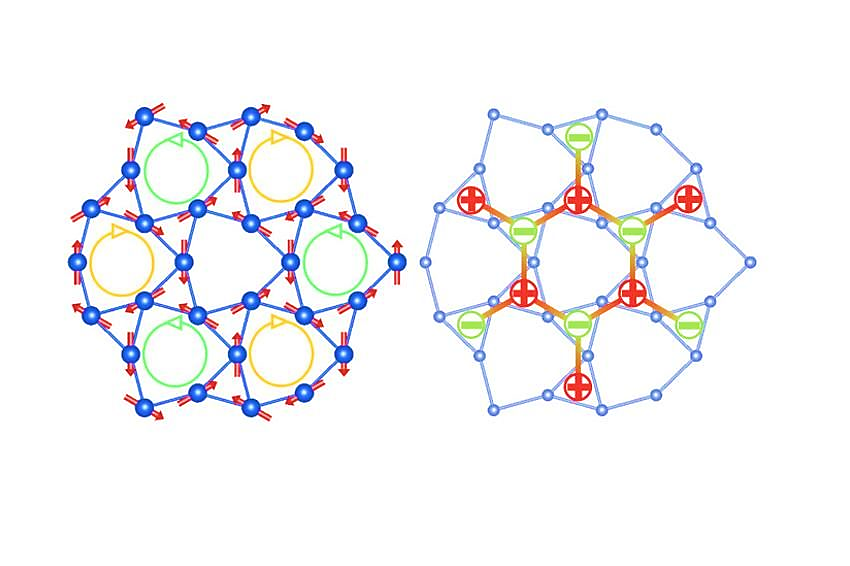Apr 8 2020
Although magnetic monopoles are not viable in reality, at low temperatures, specific crystals can consist of what are called quasi-particles that act as magnetic monopoles.
 In HoAgGe, holmium spins occupy the corners of triangles that are arranged in a Kagome pattern. The alignment of adjacent spins (left, red arrows) must obey the ice rule: Either two spins protrude into a triangle and one protrude out, or vice versa. As a result, the individual triangles behave as if they were magnetic monopoles (right). Image Credit: © Uni Augsburg.
In HoAgGe, holmium spins occupy the corners of triangles that are arranged in a Kagome pattern. The alignment of adjacent spins (left, red arrows) must obey the ice rule: Either two spins protrude into a triangle and one protrude out, or vice versa. As a result, the individual triangles behave as if they were magnetic monopoles (right). Image Credit: © Uni Augsburg.
At present, an international collaboration of researchers has shown that such monopoles also exist in a Kagome spin ice system. Decisive factors were, apart from others, measurements using inelastic neutron scattering at the NEAT instrument of the Berlin neutron source BER II. The study findings have been reported in the Science journal.
In 2008, for the first time, researchers detected magnetic monopoles across the world from the Berlin Neutron Source BER II. They were found in a dysprosium compound’s one-dimensional (1D) spin system. Nearly a decade ago, scientists also identified monopole quasi-particles in two-dimensional (2D) spin-ice systems, including tetrahedral crystal units. But these spin-ice materials were found to be electrical insulators.
Now: Magnetic Monopoles in a Metal
In collaboration with research groups from the Heinz Meier Leibnitz Centre, Forschungszentrum Jülich, the University of Colorado, the Academy of Sciences in Prague, and the Helmholtz-Zentrum Berlin, for the first time, Dr Kan Zhao and Prof Philipp Gegenwart from the University of Augsburg have demonstrated that such magnetic monopoles can also be formed a metallic compound.
For this purpose, the researchers from Augsburg developed crystalline samples from the elements of holmium, germanium, and silver.
Kagome Spin-Ice System Means Frustration
The magnetic moments, or spins, of the holmium atoms in the HoAgGe crystals form a so-called 2D Kagome pattern. It has been named after the Japanese Kagome braiding art, where the braiding bands are woven such that triangular patterns are formed, and not at right angles to each other.
In the Kagome pattern, the spins of neighboring atoms can not be aligned opposite to each other typically. Rather, two permitted spin configurations exist. In the first one, the spins of two of the three atoms point accurately toward the center of the triangle, while those of the third atom point out of the center.
In the second one, it is exactly the opposite: One spin points to the center, while the other two point out of it. Since this reduced the spin arrangement possibilities, it has been termed “Kagome spin ice.” As a result, the system acts as if magnetic monopoles existed inside it.
For the first time, this behavior has been experimentally demonstrated in HoAgGe crystals by the collaboration led by the Augsburg researchers. The samples were cooled to near absolute zero temperature and investigated under external magnetic fields of differing strength.
Part of the experiments was performed at the Heinz Maier-Leibnitz Centre in Garching near Munich. The department of sample environment of the HZB offered its support by providing a superconducting cryomagnet for the experiments at the FRM-II.
Data on the Spin Energy Spectrum at NEAT
The researchers could produce different spin arrangements predicted to occur in a Kagome spin ice system. As part of model calculations by the Augsburg research group, the probable appearance of the energy spectrum of the spins was predicted. Then, this energy spectrum could be measured through the inelastic neutron scattering method at the NEAT instrument at the Berlin neutron source.
This was the final building block for detecting the magnetic monopoles in this system. The agreement with the theoretically predicted spectra is really excellent.
Dr Margarita Russina, Helmholtz-Zentrum Berlin
Dr Russina is responsible for the NEAT instrument at HZB.